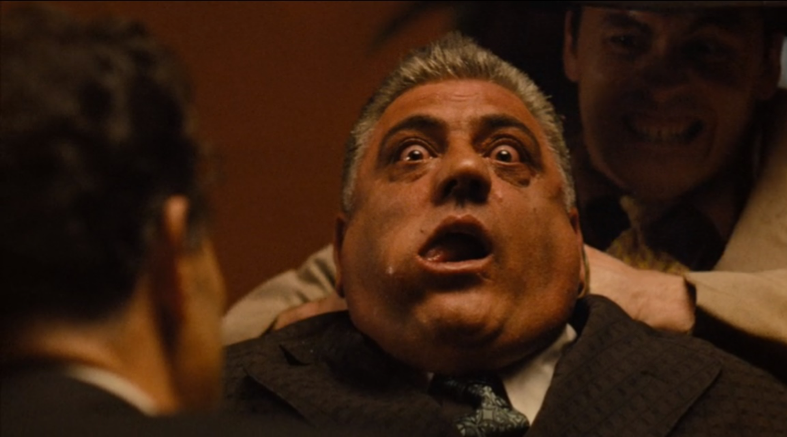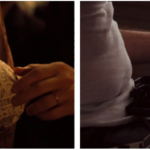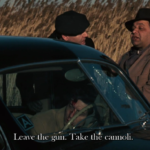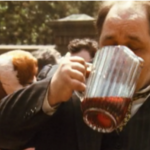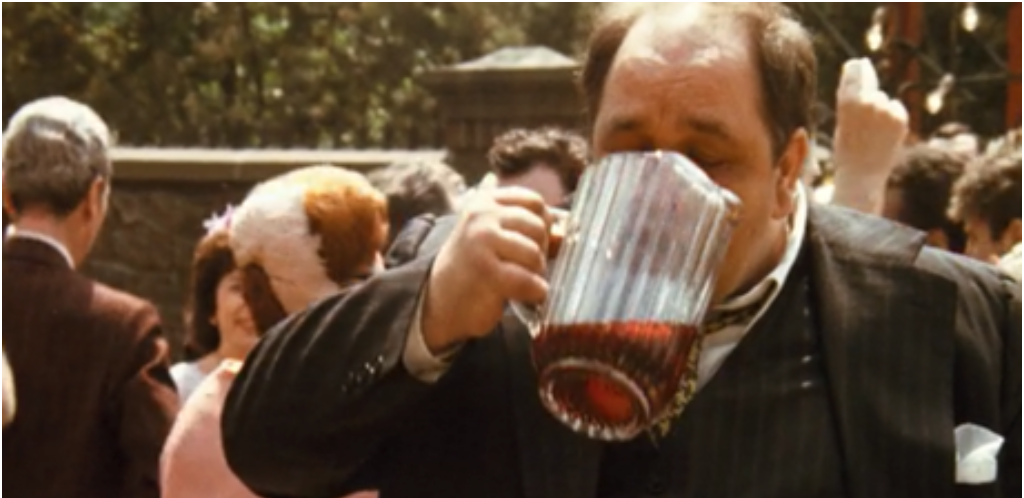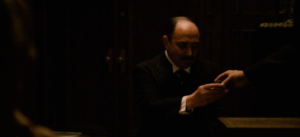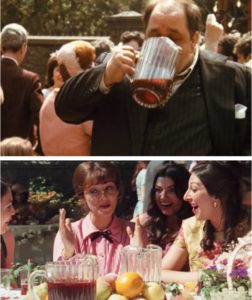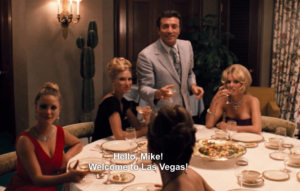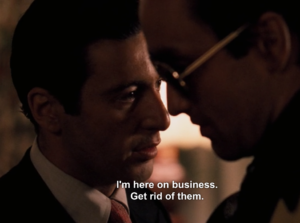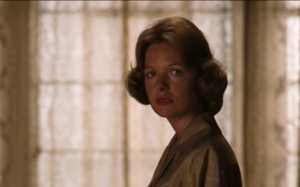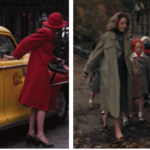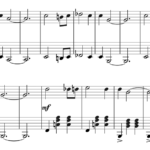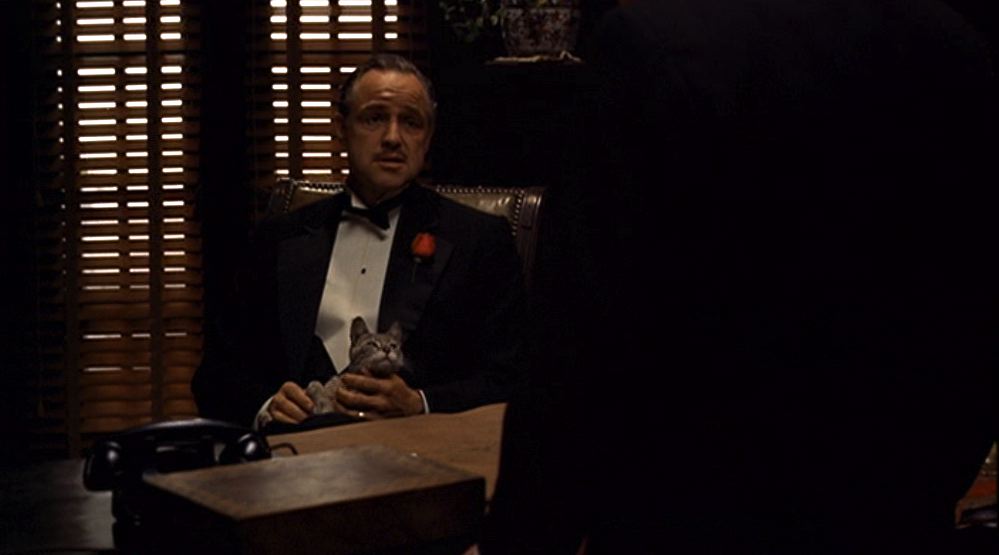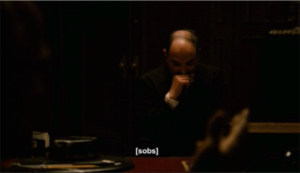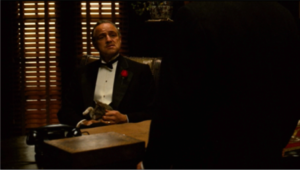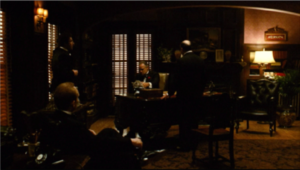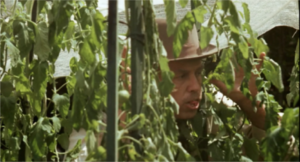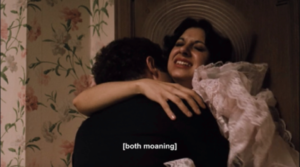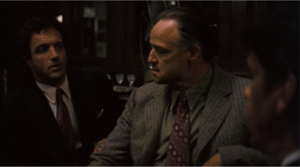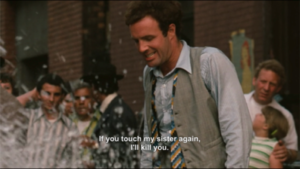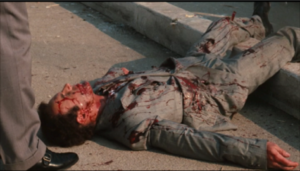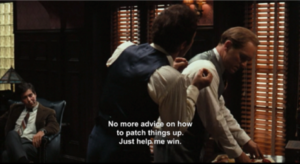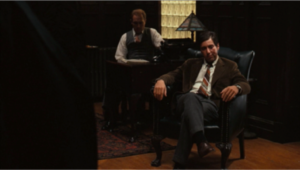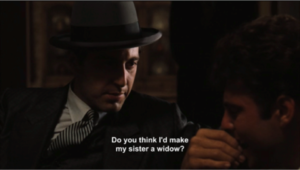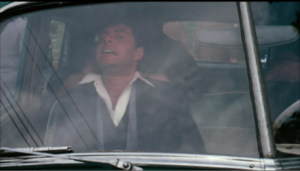The Murder of Luca Brasi: The Curiously Moving Death of a Henchman
By Jenna Allen
The scene begins with the camera positioned at a low angle, hovering just above ground level. We are transported into a setting never before seen, one that is fashionable, well-decorated, Art Deco-themed, and visually intriguing. It is a mere hallway but spacious, a series of platforms and stairs—pristine, white, heavily mirrored, gold-accented, and possessing an opulence that plainly states “luxury.”
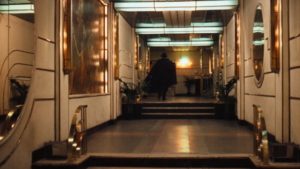
We see the lone figure of Luca, whose back faces the camera, dressed in all black and ascending the stairs. His garments are dark-toned, contrasting with the surge of brightness that is the background. His looming stature fills up almost the entirety of vertical space from ground to ceiling, as he ascends with a casual, confident gait. He is out of place—a dark, lonely figure situated among a landscape of brilliant white. When he reaches the top he removes his coat and, if we were unsure before about the identity of the tall figure, the wide profile allows us to see him clearly now: it’s Luca Brasi, Don Corleone’s most valued henchman.
The surrounding mirrors display his dark demeanor—his sober, calm professionalism—in multiple dimensions, but there seems to be one essential Luca. He is, indeed, a professional. He is a man sent out on a mission—a mission by Don Corleone.
There is something ironic about Luca’s presence here, and it is not simply his appearance. From the previous scene, we already know that Luca is to prepare the bait, to feign discontent with the Corleone family, and to ultimately test the waters for this newly emerging character, Sollozzo. Luca’s loyalty is executed in the form of a betrayal—one that is acted, of course. Thus, when Luca first steps foot into the club, with the intention to carry out the Don’s plan, a silent tension smothers the air. This is all a test.
It is a test for Sollozzo—in the most obvious sense, we want to know if he can be trusted—but more so it is a test for Luca, our principal interest in this scene. We are here directed to see how Luca will fare, this loyal, eagerly-obliging man who has been thrust into the Don’s dirty work. We cannot help having some stored attachment for this man, who first endears himself to us at the wedding with his poorly performed thank you to the Don. Thus, when Luca dies on an errand of loyalty, we register heavy tremors of shock. A sense of loss, keyed to the corruption of Sollozzo and Tattaglia, begins to color The Godfather, often exploding upon us in the most sudden and savage of ways..
Though the impact of Luca’s death scene has much to do with surprise, it also has deeper, more complex roots. Our emotional response to Luca’s death hinges on what we’ve come to know about him: at this point in our experience of the film, he is not just some brawny, dispensable crony, but rather an actualized, round character. In Puzo’s novel, Luca Brasi’s loyalty to Don Corleone is established through a long history of violence—murders committed on Corleone’s behalf. (Annotated Godfather, 75) In the film, Brasi is a much-abbreviated version of this ruthless killer, but he is fleshed out just enough, and with singular idiosyncrasies, to draw our attachment.
* * *
First impression-wise, it is difficult for the viewer to focus on any aspect of Brasi other than his gigantism. He possesses all the properties of a menacing assassin whose sheer bulk and size instantly disclose his raw strength. Kay echoes this notion at the wedding, remarking to Michael in a low tone, “See that scary guy over there?” The actor who fills this “scary guy” role is 6’6” Lenny Montana, an ex-wrestler who had been known by the moniker “The Zebra Kid” and was the World Champion at one point. (Annotated Godfather, 37) Such a figure inadvertently dwarfs all the wedding guests around him.
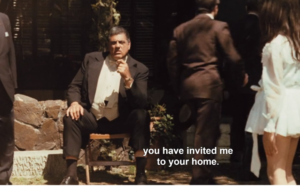
But the longer the camera focuses upon Brasi, the more we see of his contrasting, almost endearing interiority. The “big scary man” who is talking to himself is actually frozen in deep concentration, fumbling and repeating the same words over and over again. He strains himself in the midst of merriment. Everyone around him is alight with joy and then there is Brasi, mumbling to himself, a heap of nerves. There is something sweet about a man who does not match the fear he inspires—who is quickly deemed the ‘scary’ guy while possessing a slightly softer, grateful side within.
The death of Brasi is much more than transactional—not “strictly business,” to use a phrase from the film. It is emotionally affecting.
By suppressing Puzo’s version of Brasi, who is marred by a more unforgivable past, Coppola gives us a Brasi who is known only by his loyalty. This Brasi exhausts himself with perfecting a memorized speech of gratitude, and even gives money afterward for the bridal purse of the Don’s daughter. Yes, he kills for Don Corleone, but he also receives an invitation to an exclusive family wedding; we come to know him purely through this bond to Don Corleone. His death, then, is much more than transactional – not “strictly business,” to use a phrase from the film. It is emotionally affecting —the poignant consequence of his “pledge [of] never ending loyalty.”
***
At the start of the scene that leads to his death, we already know what Luca Brasi really is. He is a fabricated defector who must, for now, bury his unshakable allegiance to Corleone. When he steps into this lavish place of meeting, we as viewers are thrust into a moment of waiting, a moment of pressing uncertainty. The gold ornamentation, the trendy aesthetics, the overall unspoiled feel—burgundy walls, golden dim lights, everything shrouded in shadow: all these elements foster a mellow ambiance. Surely, no violence can erupt in a place as sedate and sophisticated as this? And even if it does, we have faith in the reliable, tried-and-true Brasi.
When we meet the figures of Bruno Tattaglia and Virgil Sollozzo inside, there is something about them that blends into this cool, fashionable setting. This is the Italian-American Mafia—sleek entrepreneurs, cleverly veiled criminals—and this is where they meet, as businesspeople accustomed to a tableau of luxury. Tattaglia immediately sets the tone, introducing himself as if he were all smiles and good cheer: “Luca! I’m Bruno Tattaglia.” He effortlessly assumes a businessman’s air of affability, embodying a type of bold cordiality that is difficult to second-guess.
“I know.” Brasi’s curtness marks a break with the manufactured pleasantries. Brasi, in fact, seems incongruously situated here from the start. The inaptness of the meeting is magnified by his unrelenting stoniness.
Meanwhile the camera angle captures the scene from the characters’ torsos up, panning back and forth frequently, with equal attention capturing each expression. Tattaglia maintains an easy casual aura, standing directly under a cascade of light, smiling as he speaks, professional and almost jovial. When Sollozzo enters, taking his place beside Bruno, he mimics this air of friendliness.
The opposing sides are clear contrasts in this way. Sollozzo, chatty and encouraging, leads the conversation with a piercing, alert gaze. He dresses warmly, in welcoming beige and camel-colored tones—all in all, appearing as a lighter flash of color against Luca, who is on the opposite side, darkly attired, stoic and shadowed, with a reserved nature that seems unwittingly out of place.
As with many scenes in The Godfather, we could not possibly have guessed the coming action. In a brief, preceding scene, Brasi, in preparation, dons a bullet-proof vest while he loads his gun. “The audience is probably waiting for the vest to come into play,” Coppola writes in his notebook. “This is a beautiful piece of misdirection.” (Annotated Godfather, 75)
The business pauses for a moment, as Brasi, thinking the ‘deal’ over, takes out a cigarette. Then the quiet, steady hum of this scene is shattered in an instant. With swift movements and efficient teamwork, the violence occurs almost too quickly to even process. Tattaglia drops his amiable facade, and the camera zooms in as he grabs firmly onto Brasi’s arm. Next, a knife plunges into the frame and lands with a tell-tale thud into Brasi’s restrained hand.
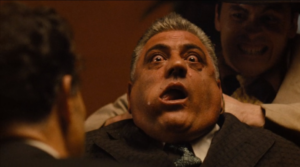 We hear a simultaneous scream, made more unsettling by its deepness, and by our awareness that it comes from a grown man who cannot suppress the anguish of his pain. And just like that, without warning, we are ejected at once from the scene’s mellow, easygoing tempo to one of fast-paced horror. By the time the garrote is placed around Brasi’s throat by an unknown assailant, we want Luca to overpower him, to use brute strength or even his gun to turn the outcome around. Ultimately, we just want his suffering to stop.
We hear a simultaneous scream, made more unsettling by its deepness, and by our awareness that it comes from a grown man who cannot suppress the anguish of his pain. And just like that, without warning, we are ejected at once from the scene’s mellow, easygoing tempo to one of fast-paced horror. By the time the garrote is placed around Brasi’s throat by an unknown assailant, we want Luca to overpower him, to use brute strength or even his gun to turn the outcome around. Ultimately, we just want his suffering to stop.
But there is no easy escape. Instead of ceasing, Brasi’s strangulation is extended as long as possible. In this striking, visually repulsive moment, we are forced to endure his death in its entirety. Luca’s gasps become softer. His face becomes tinged with a purple, bruised color. His eyes are pushed out of their sockets and become two vacant bulges as his tongue sticks unnaturally outside his mouth. In preproduction, Coppola’s special effects memo reads, “This is probably the most difficult effect in the movie.” Luca’s dying moments here are backed by sufficient research to capture all the unpleasant physiological changes that occur realistically with strangulation. (Annotated Godfather, 76) This scene holds nothing back. Once the choking Brasi ripens to the complexion of a grape, and his limp figure starts to slip under the table, we have to accept the imminence of his death.
Yet Luca’s drawn-out suffering and the morbidly jarring violence of this scene are not inserted in the film simply for the sake of violence, simply to titillate or transfix the viewer. Brasi’s suffering is key to the film’s greater significance, as this short scene marks a monumental turning point within it. From his death alone, The Godfather forges its overarching conflict and defines the ensuing direction of the plot. It takes one scene to dramatically color Sollozzo and Tattaglia as merciless villains.
The murder of Luca Brasi colors Sollozzo and Tattaglia as merciless villains, and seeds feelings of shock, disgust, betrayal, and sadness—out of which emerges the heightened question, “What next?”
The scene seeds, within the audience, feelings of shock, disgust, betrayal, and sadness—out of which emerges a heightened wonder of ‘What next?’ Moreover, Luca’s eventual death does not mean an end to the violence; it is, in fact, the jump starter for it. Brasi’s death, then, opens onto many forms of loss—the loss of a trusted friend, the loss of peace among the Five Families, and all the human losses that we anticipate will arrive with the unprecedented storm that is about reach the Corleones.
Jenna Allen (’18) is a Cal undergrad working on her B.A. in English Literature.
Works Cited
Jenny M. Jones, The Annotated Godfather (New York: Black Dog & Leventhal, 2007).

